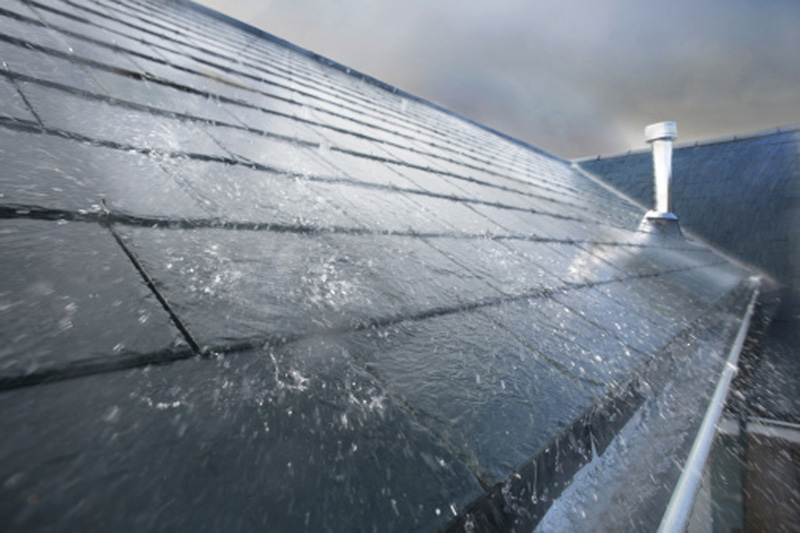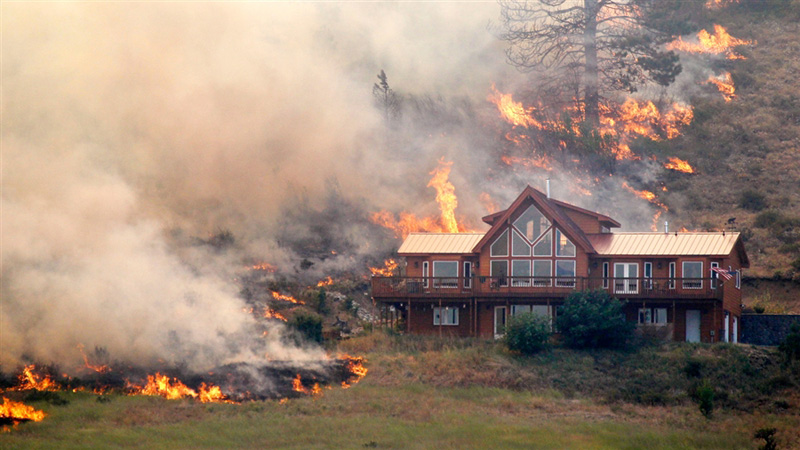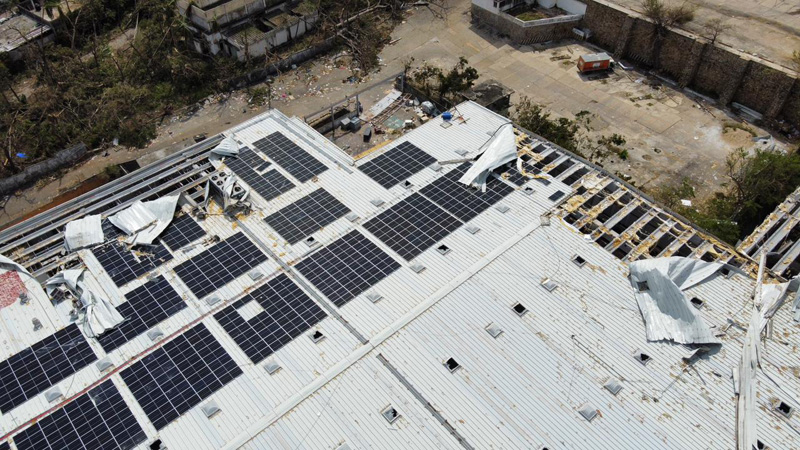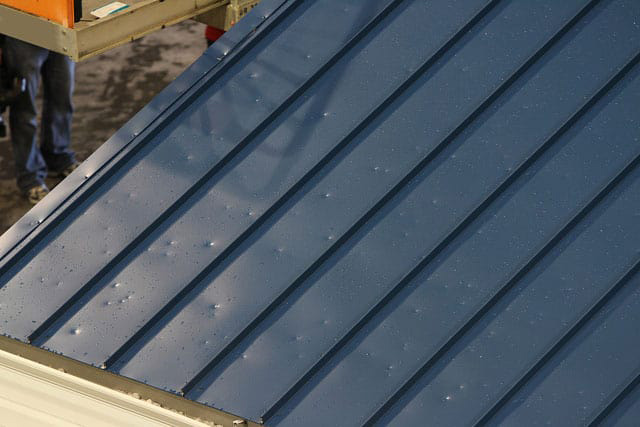Weathering the storm: The durability of metal roofing

As extreme weather events like the recent wildfires in California and hurricanes in coastal communities become more frequent, owners and designers increasingly recognize the critical need to reinforce their construction projects against the potential damage severe weather conditions can inflict on homes and commercial properties. Standing seam metal roofing provides a durable and long-life solution.
The roof is the first line of defence when nature unleashes its fury in terms of wind, wildfire, and hail, which raises important questions for the AEC industry. What should professionals keep in mind? What are the areas of concern, and what can be done to combat extreme weather conditions? Let’s explore.
Damaging winds
Wind creates powerful “uplift” (suction) forces on a roof. Different areas (“zones”) of the roof experience these forces to varying degrees, some higher than others. A standing seam metal roof can be engineered to withstand virtually any uplift force desired or mandated by building code authorities—up to and including Category-5 hurricane forces and even tornadic wind forces.
However, this degree of wind resistance does not magically happen but results from careful design, testing, attachment, and installation specifications. Unlike many other roofing materials, metal’s mechanical properties remain stable over time, so it will perform as designed throughout its decades-long service life.
Of course, the more durable the design, the higher the roof’s initial cost. Designing to exceed building code requirements may not always be economically feasible, but that is a personal or business decision and certainly an option.
Also, it is important to note that code requirements for wind forces have generally increased in recent decades. A roof designed in 1990 may not comply with today’s more stringent standards. Roof durability in a windstorm may also depend upon the building’s structural design—if the structure to which it is attached fails, so will the roof.
In post-Hurricane Irma inspections, the Monroe County, Florida’s staff summary found that “metal roofs fared far better than those roofs covered by asphalt shingles,” prompting county officials, in recent years, to propose an ordinance that requires all new or replacement roofs to be metal. This is a true testament to the sustainability and durability of metal roofing, particularly in high-wind areas.
The exceptional performance of standing seam metal roofing in high-wind conditions is due in part to its structural attachment methods, frequency, and interlocking joint features, which reduce the likelihood of wind detaching the panels. Most importantly, metal is an inert material, unlike membranes or asphaltic materials, ensuring its mechanical properties do not diminish over time and under exposure to UV and other environmental conditions. In other words, it will behave as tested throughout its life of 60 years or more.1
Standing seam metal roofing offers a distinct advantage over other roof types, such as membrane and hot-applied asphaltic roofs, because it acts as a “structural” covering and can be engineered to withstand almost any force imposed by wind. When designed as such, some structural standing seam profiles can withstand extremely high wind pressure, making metal the roof of choice in high-wind regions.
By increasing the frequency of attachment, increasing the gauge thickness of the metal, decreasing the panel width or, using external seam clamps, or any combination of these together can measurably increase the durability of the roof in a windstorm.
Hail

Different building materials react to hail impact to varying degrees. While hail may cause minor dings in siding, gutters or asphalt shingles, larger and more dense hailstones can cause severe damage and even puncture a roof.
Metal roof material is the most reliable defence against hail damage. The extent of the damage depends on factors such as the size and hardness of the hailstones, the type and thickness of metal, and the substrate to which it is installed. Steel roofs, for example, are much less likely to dent from the hail than a vehicle, which uses softer grades of steel that can be easily moulded into the sleek lines and curves of an automobile.
While most insurance policies distinguish between functional damage (which affects water resistance) and cosmetic damage (which does not), esthetics may still be a concern in high-visibility areas. Some may view hail dents as a flaw, while others appreciate them as part of the roof’s character, emphasizing its durability over time. In architectural design, esthetic considerations can vary widely—some embrace natural weathering effects, while others prioritize pristine appearances. Ultimately, whether esthetic damage is a performance concern depends on the owner’s expectations and the roof’s intended application.
Generally, a 0.51-mm (24-gauge) thick steel roof will typically remain functionally undamaged by hail up to 24.5 mm (1 in.) diameter. However, copper 453.6-g/m² (16-oz./sf) thick is another story because it is softer and may be more vulnerable to cosmetic annoyance. Despite the claims of many “storm-chasers,” it is extremely rare for hailstones, even of significant size and velocity, to impact a roof’s functionality to necessitate its replacement. Claims suggesting hailstones can significantly affect the function of a metal roof are almost always unfounded and rarely factually supported.
A recent study by the Metal Building Manufacturers Association (MBMA) and subsequent ASTM symposium paper provides solid data to back this up.2
Snow and ice

Snow presents unique challenges for any roof type. The migration of snowpack, accumulating snow on the roof, can put significant stress on roof flashings and drainage systems. It can also produce significant sliding forces on steep roofs, resulting in the sudden release of snow (and ice), dumping tons of the fallout below the eaves in seconds. This causes hundreds of millions of dollars in property damage, personal injury, and even death each year.
Re-freezing meltwater on a roof can wreak havoc. When the roof warms from the invisible spectrum of the sun’s rays or from building heat loss, snowpack begins to melt—the runoff refreezes at the eaves. The eaves are as cold as the (colder) ambient air temperature. So, when it is frigid, ridges of ice (ice dams) can build up, preventing meltwater flow and drainage at the roof edge. Static water pressure above the ice dam may infiltrate the roof panels, potentially causing damage to the exterior walls, insulation attic and building interior, resulting in rot, mould, and watermarks. Left unchecked, this problem will persist each time the same conditions exist. Ice dams as thick as 457 mm (18 in.) or more have been reported.
Pitched metal roofs, manufactured from materials that create a slippery surface, can increase the risk of sliding snow, sudden rooftop avalanches and ice hazards in the discharge areas below the eaves. The most effective way to mitigate these risks is by installing a scientifically tested and engineered snow retention system designed to handle the snow loads expected on the specific roof profile. Ideally, this system should comply with the only recognized consensus standard, Evaluation Criteria 029-2018 for Standing Seam Metal Roof-Mounted Rail-Type Snow Retention Systems, developed by the International Association of Plumbing and Mechanical Officials (IAPMO). To ensure compliance, request the “Evaluation Report” issued by IAPMO, a crucial document when vetting or specifying snow guard systems.
Lightning and fire

When it comes to lightning and fire, metal is the clear choice. Unlike other roofing materials, metal roofs will not spark and ignite into flames, making them safer during a lightning strike or wildfire. Additionally, metal’s non-flammable characteristic reduces the risk of external fires spreading to the building.
A common misconception is that a metal roof “attracts” lightning. In actuality, lightning finds its way to Earth, based primarily on the building’s height relative to its surrounding terrain, structures or trees, so a metal-roofed home is no more likely to be struck than any other roof type.
Most lightning-related damage and fires occur when the lightning charge passes through non-conductive materials such as wood, masonry, or stone on its way to the ground. A steel-framed, metal-roofed building is one of the safest places during a lightning storm, as the structure provides a direct, conductive path for any potential strike to reach the ground.
For metal roofs installed over non-conductive materials, grounding is a widely accepted practice, particularly in Europe, where a simple conductor running from the roof to a grounding rod is commonly used. While the lightning protection industry in some regions requires more complex and costly approved systems, basic grounding can be a practical and inexpensive way to enhance protection. However, in metal-framed structures—such as pre-engineered metal buildings—grounding is generally less critical, as the structure itself serves as an immediate path to ground.
Regardless of the structure type, it is always advisable to maintain a safe distance from walls during a lightning storm, as they can conduct the charge.
Conclusion
Metal is considered the most environmentally friendly and sustainable roofing material available, and it is known for its long-lasting performance and reliability.3 It offers exceptional durability in extreme weather conditions, is 98 per cent recyclable,4 and is made from up to 90 per cent recycled material, depending on the type of metal.
A standing seam metal roof can be engineered to withstand virtually any wind uplift force and can be reinforced even post-construction. It is highly resistant to hail damage, can effectively manage snow and ice with an engineered snow retention system, and is non-flammable, so it will not spark and ignite into flames during a wildfire or lightning strike.
Manufacturers must develop products to increase a roof’s resilience and address some of the most challenging conditions roofing and exterior projects often encounter.
Notes
1 Metal Construction Association. 2018. “Service Life Assessment of Low-Slope Unpainted 55% Al-Zn Alloy-Coated Steel Standing Seam Metal Roof Systems.” October 2018. metalconstruction.org/index.php/online-education/service-life-assessment-of-low-slope-unpainted-55-al-zn-alloy-coated-steel-standing-seam-metal-roof-systems—published-102018
2 See STP 1650, 2023—available online at astm.org,
doi: 10.1520/STP165020220099, astm.org/stp16502
0220099.html
3 See note 1.
4 Modern Steel Construction. 2023. “EAF Statistics.” Modern Steel Construction, May 2023. modernsteel.com.
Metal’s non-flammable characteristics reduces the risk of external fires spreading to the building.
Photo credit getty images/HPW
A heavy buildup of snow and ice on this pitched metal roof highlights the risk of sudden rooftop avalanches, emphasizing the importance of installing a properly engineered snow retention system.
Author
Rob Haddock, CEO and founder of S-5!, is a former contractor, award-winning roof-forensics expert, author, lecturer and building envelope scientist who has worked in various aspects of metal roofing for five decades. S-5! recently achieved an Evaluation Report of compliance (ER) to IAPMO EC 029–2018 industry standard for testing and certifying snow retention devices. For more information, visit s-5.com.










